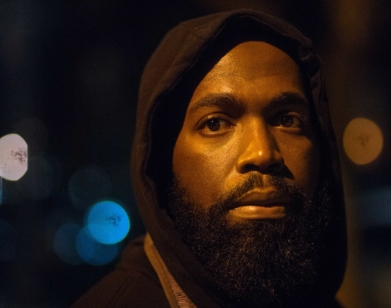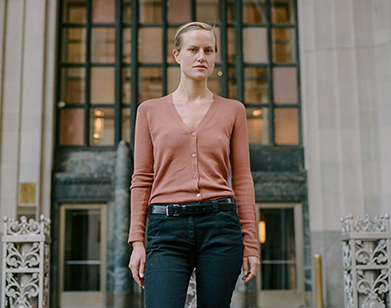Alfredo Jaar: All art is socially conscious
Most days, at 8 A.M., Alfredo Jaar can be found in his Chelsea studio, alone, eating breakfast and reading the news. The Chilean artist reads for two hours about politics, international affairs, injustices, tragedies, and disasters both natural and inflicted from over 30 different outlets. This the beginning of Jaar’s practice, meticulously accruing information that forms the nuclei of his artwork.
Over the past three decades, Jaar’s work has revolved around violations of human rights and, in particular, humanity’s compliance with inhumanity. From famine in Sudan and gold mining in Brazil to Vietnamese refugee detention centers in Hong Kong and the Nicaraguan Civil War, Jaar combines photography, cartography, and language to question the ethics of image and representation.
Take one of his most well-known works, The Rwanda Project (1994–2000), for which Jaar spent six years following the genocide and its brutal aftermath, amounting to a series that reflected the indifference of the world as witness. In one piece, he displayed various covers of Newsweek beside the climbing death counts in Rwanda—a magazine cover featuring “magic pills” and vitamins exhibited against a caption that read, “April 21, 1994 […] 50,000 deaths”—as testament to both the media’s negligence and the public’s passivity.
Silence rings loudly throughout Jaar’s body of work. It takes the form of erasure, for example, in A Logo for America (1987), where Jaar addresses the U.S.’s ethnocentrism in a series of projections on a billboard over Times Square; one screen displayed the sentence “This Is Not America” strewn across a silhouette of the country, suggesting that the remainder of the continent is consistently silenced by the U.S.’s monopoly of the word “America.”
One Million Finnish Passports (1995) opposed Finland’s unyielding immigration laws and consisted of a million blank Finnish passports stacked neatly behind a glass wall reminiscent, perhaps, of a holding cell. What resonates here is absence: the infinite futures constrained within the finite number of passports, symbolizing one million lives not led. For Lights in the City (1999), Jaar installed red lights in Montreal’s Marché Bonsecours. He placed devices in homeless shelters throughout the city and urged people to, upon entering, press buttons that triggered the lights; Montreal’s landmark building was set ablaze, literally shedding light and giving presence to an oft-forgotten community.
However socially conscious his works may be, Jaar rejects the label of “political artist,” insisting that he is more of a “project artist.” Interview recently caught up with him over the phone to discuss his new commission for the Yorkshire Sculpture Park in England, politics, and America.
PIMPLOY PHONGSIRIVECH: I’m excited to hear about your new piece at the Yorkshire Sculpture Park. How’s it going?
ALFREDO JAAR: It’s going very well. The Garden of Good and Evil is an outdoor installation to celebrate the park’s 40th anniversary. It consists of 101 trees in cubic planters, which measure one by one by one meter. Perfect cubes. So there are 101 of them and they are placed in a grid. There are five rows and [each row has] 22 trees, approximately two meters apart. These are tall trees, so when you sit on the field from a distance you’ll see this very beautiful grid of trees, five by 22. Very well organized.
You will not see the cells from a distance, you have to actually enter the grid and start walking inside to suddenly see that there’s a tree missing there, another missing there. These cells have different heights; some are cubic cells, others are tall. They are made of metal, anchored on a concrete base and the doors are open so you can actually enter. Some you can sit in, some you can stand.
These cells are cells that have been used by the U.S. State Department in different countries. They’re black sites and completely outside the law: people get killed, people disappear, and people get tortured. The cells are based on readings I’ve done. Some are completely enclosed and only have a hole in the top. The smaller ones, the cubic ones, you’re on your knees and you can just put your head in the hole—they’re really just for torture, the “evil” part of the garden.
PHONGSIRIVECH: You once talked about the challenges of balancing information and poetry in your work. How do you find the line between didactic and, well, poetic?
JAAR: I think I’m a journalist in one sense—I want to communicate to people about certain things that are happening around us, around the world, close or far. In order to transform this information into art you have to add poetry. It’s essential. When the work strikes a perfect balance between the two, it is sublime. It’s a fantastic work of art that touches the audience, that illuminates, that informs, and that moves them to action. Most of the time the work fails. Either it is too informative and the poetry is lost in the information and so it becomes, well, boring and too close to pure information. Or sometimes it fails when it falls into the other extreme, when the construction, the display, is too poetic and people are struck by the beauty that they do not see the content. Unfortunately I feel that most of my work fails either one way or the other.
PHONGSIRIVECH: You often say that your art is informed by context—
JAAR: Reality. My work is always based on reality. I’m not an artist that creates works of fiction. I’m not an artist who is in my studio inventing things out of my imagination—everything is based on reality, on real facts.
PHONGSIRIVECH: So how do you determine which realities to engage with?
JAAR: I read 35 different news media from around the world in different languages—some official, some alternative. I’m fascinated by how they’re covered around the world. When you read a story in El País, a socialist paper from Spain, it’s very different from when you read it in The New York Times or the Washington Post. You look at these events from different points of view and accumulate an enormous amount of information, and you have to read between the lines to understand really what’s going on.
I follow many tragedies around the world. At one point I [will] feel like I’ve accumulated an enormous amount of information, a critical mass amount of information, and I feel like acting—reacting. My manifesto has always been the same: I cannot act in the world before understanding the world. I will not move a finger. I will not come up with any ideas—nothing—until I actually understand what is happening.
PHONGSIRIVECH: It’s fascinating to see how the world understands your works, too. I feel that often, as you say, your work “fails” when it is taken out of context, or when its context has drastically changed. It brings to mind A Logo For America.
JAAR: Certainly when you do a work for a public space, you lose control. Anything can happen. In the case of A Logo For America, it started as a semiotic work about language. I was shocked when I moved to New York in 1982 [and] I heard people on the news, on TV, on the radio, in the newspaper saying, “God Bless America,” “Welcome to America,” America this, America that, [and] referring to the United States but not the rest of the continent. So I was upset because I’m an American—I am Americano. I was born in Chile, and for any Latin American, America is our continent. You feel in the daily language that Americans use the word “America” to erase the rest of the continent from the map. And, of course, the language is clearly a reflection of the geopolitical reality: the domination of the United States over the rest of the continent.
PHONGSIRIVECH: And then the piece resurfaced two decades later to a completely different reality.
JAAR: Yes, 27 years later, the Guggenheim acquired the work and decided to display it again in Times Square. There had been a lot of discussion during Obama’s second term about what it means to be an American because the Obama administration exposed almost three million immigrants in four years.
PHONGSIRIVECH: And today? With all the talk about “America First,” American greatness and whatnot, it has a whole new life.
JAAR: Right. Nowadays I see my work being used, without my permission, [laughs] as if it was an attack against the Trump regime. People want to say, “No! That’s not my America, not the America I know.” I’m honored—it’s just not me. But as we were saying before, the artist loses control.
PHONGSIRIVECH: Do you think art has to engage with politics to have cultural value?
JAAR: I think that all art is socially conscious. There is no alternative. Whatever we produce contains a political and social statement. There’s no way to avoid that, unless it is pure decoration. But even pure decoration has also some value because you can read pure decoration as a way to ignore the reality that is around us, saying, “Well, I’m not interested. I just like to paint this wall blue.” So everything we do can be read politically. It’s intrinsic to its function and its being.
ALFREDO JAAR’S EXHIBITION AT YORKSHIRE SCULPTURE PARK, INCLUDING THE GARDEN OF GOOD AND EVIL, WILL BE ON VIEW FROM OCTOBER 14, 2017 THROUGH APRIL 8, 2018.






